How Is Biodiversity Loss a Scale Problem?
Biodiversity Loss Higher Than Ever
In the history of the earth there have been five periods of mass extinctions. The sixth such period is occurring now and is projected to be the highest ever. There are two unique features of the current episode:
- it is the only occurrence triggered by human activities
- it is occurring faster than any previous mass extinction.
The 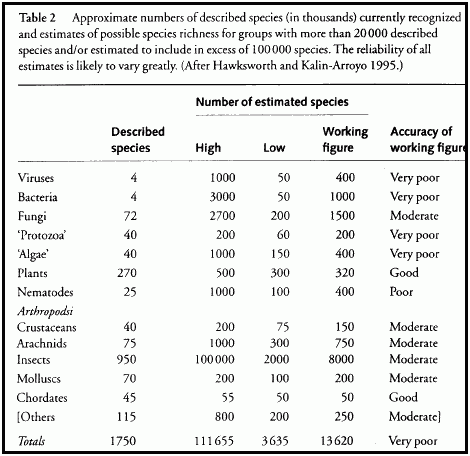 current rate of species loss is believed to be some 100 to 1000 times greater than the preindustrial rate. In addition to extinctions, more species are endangered than ever before and the number of species at risk continues to rise. Many species are experiencing declining populations, a potential precursor to extinction.
current rate of species loss is believed to be some 100 to 1000 times greater than the preindustrial rate. In addition to extinctions, more species are endangered than ever before and the number of species at risk continues to rise. Many species are experiencing declining populations, a potential precursor to extinction.
Reduced populations also reduce genetic variability which in turn reduces the species’ resilience or ability to adapt to changing environmental conditions (see Quick Facts). This is occurring when other scale problems are altering the climatic stability upon which species depend (see Ozone and Climate Change).
Extinctions Faster than Respeciation
Sustainable scale requires that the rate of throughput not exceed the rate of regeneration. From a sustainable scale perspective, the rate of respeciation, or rate at which new species evolve, relative to the current rate of extinction, determines whether the level of biodiversity is sustainable.
Extinctions occur much more rapidly than new species can evolve. While the current rate of species extinction is higher than ever, the rate of respeciation remains unchanged; it can take millions of years for a new vertebrate species to emerge. After each of the previous mass extinctions, it took 5-10 million years for biodiversity to return to its previous level. A mass extinction caused by humans will have irreversible repercussions that will extend 2-3 times the period that humans have been on the earth.
Humans Taking the Lions’ (and Every Other Species’) Share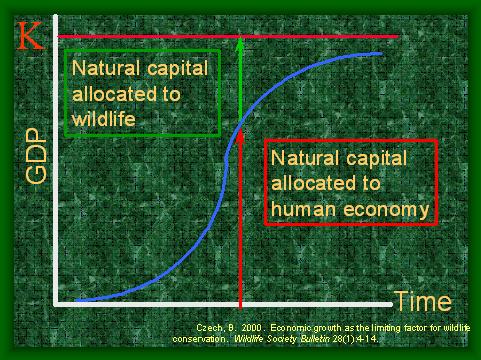
One reason that other species are going extinct is because humans have become so successful. The biological principle of competitive exclusion [glossary term] states that each species expands at the expense of others seeking to live in the same habitat. This principle applies to human activities as much as to any other species.
Our technological prowess has allowed us to become the dominant species on the planet; in the process we are making it increasingly difficult for other species to survive.
This principle can be shown as the allocation of finite natural capital to the human economy vs. what is left for the natural economy which supports wildlife. As the scale of the human population and economy expands, using more land and resources, and emitting more pollution, the space available for other creatures diminishes.
Too Much Economic Activity Endangers Species
One of the key indicators of biodiversity is the number of endangered species and number of species becoming extinct. We know rates of species extinction and endangerment are higher than background levels. We also know that there is a very high correlation between growth in the human economy (measured by GDP) and species extinction as measured by the number of species listed under the US Endangered Species Act.
An investigation into the causes of endangerment for 877 species in the United States found that the vast majority were caused by expansion of human economic activities.
1 In making this connection between economic growth and biodiversity loss it is helpful to recall that economic growth measured by GDP is not a meaningful measure of human well being (see
Measuring Wealth in
Economics For Community). Economic growth beyond what contributes to human well being is wasteful of biodiversity, as well as resources.
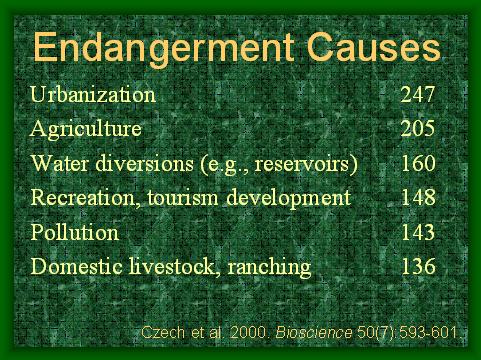
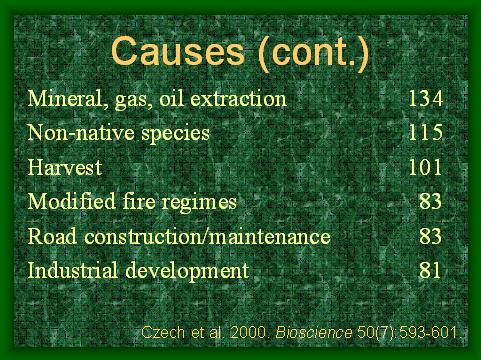
More Than Our (Survivable?) Share?
There is a finite carrying capacity of the earth (Ku in the image); as the natural capital devoted to human use (Kt in the image) approaches this limit, then the amount left for the rest of nature and biodiversity diminishes (the space between Ku and Kt). We depend on the rest of nature for our survival, so the issue of how much natural capital or biodiversity we should maintain is an issue of survival. When other species compete in an ecosystem a natural balance evolves.
If one species over exploits its own
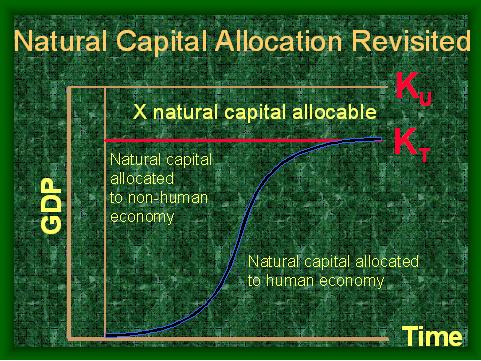
food supply, then its populations declines significantly, either to a level where both species can survive and grow again, or it goes extinct. The feedback mechanism may be painful to individual members of both species but the process is direct and eventually results either in a new population equilibrium, or the species goes extinct.
Human technologies allow us to overcome or ignore the immediate feedback results when we destroy our own life support systems (e.g. when we over fish one species we move on to another less desirable species). But this process simply delays the inevitable results of destroying the biodiversity life supports upon which we depend.
Whether the human population will go extinct by destroying biodiversity and its own life support systems, or establish a new equilibrium after a significant die-off, remains to be seen. Limiting the human allocation of natural capital and preserving biodiversity is a much less painful option.
Human Appropriation of Nature Unsustainable
One way of assessing just how much of the earth’s natural capital is being appropriated by humans is to consider Net Primary Production (NPP) [glossary term]. This is a measure of how much biomass is produced by photosynthesis, the basis for all life on the planet. The amount of NPP consumed or otherwise processed, managed or destroyed by human actions was in the 40% range some two decades ago.2 Another measure is the total amount of non-glaciated land with a human imprint, estimated to be at least 55 %.3 With projected increases in human population by an additional 50% by 2050 it is clear that these levels of human appropriation of the biosphere exceed sustainable scale. The situation is somewhat analogous to the issue of social security in developed countries with an aging population, where 80% of the population (humans in the analogy) would have to be supported by the 20 % (the rest of nature).
In Summary
Biodiversity loss and degradation is a scale problem because the level of economic activity has triggered a rate of loss that is at an all time high, and is much greater than the rate of respeciation, and because many services provided by biodiversity are critical to human survival and well being.
In addition there is the moral issue of respecting life for its own sake and not simply in terms of its relationship to human well being (see
Moral Approaches). Given the intricate and delicate interdependencies amongst all living things, of which we are a part, these two perspectives may not be as divergent as typically thought (see
Quick Facts).
References
1Czech, B., P. Krausman and P. Devers. "Economic Associations among the causes of species endangerment in the United States." Bioscience, 50.7 (2000): 593-601.
2Vitousek et al. “Human Appropriation of the Products of Photosynthesis,” Bioscience 36.6 (1986): 368.
3Smil, Vaclav. The Earth’s Biosphere. Cambridge, MA: MIT Press, 2002: p. 240.